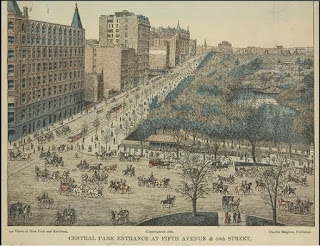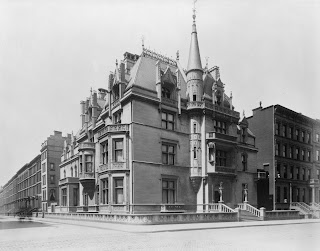William H Vanderbilt mansion 1882 57th & 5th
At last, after 10 years of nearly as much off-screen drama as on – years of rumors, flipping networks, starts, stops and plagues -- Julian Fellowes’ The Gilded Age has arrived at HBO.
Central Park + 59th Street 1880s
Although not strictly a prequel to Downton Abbey, The Gilded Age sets the 19th century table for the Downton story which would begin the year the Titanic sunk in 1912.
The Van Rhijns arrive
The Gilded Age gives us a technicolor introduction to the New York society that formed Cora, Lady Grantham. She was one of the later “Dollar Princesses” who came to Britain to buy titles and estates in the later part of the 19th century.
Mrs Russel and daughter
As Cora was born in 1868 – she would have been slightly younger than the Russell’s daughter in 1882 when the Gilded Age story begins.
Lord and Lady Grantham
I have such a fondness for Downton Abbey -- it began shooting the year I started Lost Past (I have included links throughout to all the past articles that show some of the connections).
In the years that followed, the themes of both would intertwine as I learned and wrote about great English families saved from penury by rich Americans (those “dollar princesses” like Consuelo Vanderbilt who exchanged gold for titles). I visited and wrote about gloriously restored English houses that were saved from rack and ruin by rich Americans as well as the other side of the coin - England’s Lost Houses , that were dismembered and transported by rich Americans to add pedigreed art and architecture to their new houses in Cleveland, Pittsburgh, LA and Chicago.
Bradley Martin Ball 1897
Finally I spent many a happy hour of vicarious enjoyment reading about the over-the-top opulence and ostentation of the Americans at home at NYC watering holes overflowing with luxuries like the Waldorf Hotel that hosted the infamous, multi-million dollar Bradley Martin Ball in 1897 - a P.T Barnum worthy costume party that the arriviste Russells will surely attempt to copy on Gilded Age at some point (an episode I will not want to miss).
So much of this show is, like Downton Abbey, about traditions and the tension between old and new worlds. It’s the tension between old and new money and the tension between those who fight to keep traditions and those who intend to blow them up. It is reflected in who they are and how they live and the sets and locations do a fine job of making style reveal much about the characters in the show. The styles of the Russells’ new money and the van Rhijns old money pretty much set up the drama of the show.
Boiserie from the Palais Paar, Canevale (1765-72)
Boiserie from the Palais Paar, Canevale (1765-72)
The Russells would have either had fine cabinet makers create the 18th c-style boiserie paneling for the formal rooms – or would have stripped a chateau or 2 to provide the materials and built the house to fit around the looted treasures. The house and its decoration was the best way to impress and display enormous wealth (while making a sly connection with the unfortunate material culture of pre-Revolutionary France). Their architect and interior designer, Stanford White would have made the style choices – holding his magic mirror up to his clients to reflect their glory back to them. This is what Mr. White decided set his clients the Russells off to their best advantage. It says they are very rich and very powerful and that is as good as 10 seats on the Mayflower in 1882. Mr. White was very good at this and supplied the antiques that were coming over in boatloads from the lost houses of the Continent - doubtless with a tidy profit for his trouble (White lost his warehouse of stock in an un-insured fire - ruining him at the end of his life).
Russell House
Like many, I think of Jay Gould as the inspiration for Russell what with his vast wealth, cut-throat business practices and society’s universal disapprobation for his vicious ways with commerce (the actor playing Russell also lightly resembles Gould). But for inspiration for the Russell mansion – I thought of Gould and William Vanderbilt’s style instead of White’s French confection for the show. Although the Vanderbilt exterior was a French Chateau – on the inside, Vanderbilt went for the new and exotic but terribly well made. Like Gould, he would set his own style as a king of business –he didn’t need to ape the style of toppled monarchies from the old world.
William K Vanderbilt "Petit Chateau" 660 5th Ave
The Vanderbilt and Gould palaces relied on the talents of the designers, craftsman and decorators at the Herter Brother’s firm to make 5th Avenue palaces for them both at the same time in 1879-82. The brothers had come over from Germany in the 1850s and by the 1860s they had made a name for themselves for their glorious work (although many pieces of furniture survive – almost none of their interiors do). Like White, Herter brothers did whole interiors – furniture, textiles, art and woodwork - well the whole enchilada (admittedly nearly impossible for a show to replicate without camping out at the Metropolitan Museum Herter exhibit or until computers are able to generate everything successfully). They were masters at creating a style of legend - ancient exotic kingdoms that never were - using elements from Babylon to Abyssinia to anchor the illusion and create new myths for their client emperors of industry. I have wondered at Herter creations ever since I first laid eyes on them at the Metropolitan Museum – that Vanderbilt desk (which you can see in situ in Vanderbilt’s study in the B&W photo below) fills you with awe in person at the museum. It makes you want to be terribly naughty and get a closer look at it – pull out a drawer or two.
Vanderbilt Study with the library table in foreground
Vanderbilt china display with the chairs below
Vanderbilt Parlor
Vanderbilt Ladies chair
Such outlandish luxury was not remotely acceptable to the Van Rhijn sisters who deplored the newcomers showing off and tossing tradition to the curb.
Old money brownstone houses are far more human-scaled than the new money palaces that overwhelm the inhabitants and their guests (which may be the point – to shock and awe). The van Rhijns life is smaller and they are cocooned in rich dark colors and the furniture of Belter in a style that was fashionable 30 years earlier.
Like Herter, John Henry Belter came to America from Germany but earlier - in the 1830s. By the 1840’s he had a massively successful business on lower Broadway. With backs that resembled Victorian tortoise shell combs, his laminated rosewood technique was much copied and the style came to symbolize the era.
The Van Rhijn Parlor
Remember, women of her set used to buy Frederick Worth gowns in Paris and put them in a trunk for a season or two. One was considered a gauche parvenu if they wore anything hot off the runway in Agnes’ world. Edith Wharton, in The Age of Innocence, said "it was considered vulgar to dress in the newest fashions; and Amy Sillerton has always told me that in Boston the rule was to put away one's Paris dresses for two years.”
Alice Vanderbilt in a Worth electric light costume 1883
So, we have our sets decorated in the styles of their owners and beautiful dresses to wear…
What shall we eat?? How about Election cake - a cake that’s as old as the Republic? Formerly called Muster cake, it’s a brandy-soaked cake that was made by local women to reward the militia who had traveled to train to fight in the Revolutionary War. After the war it became Election cake, and was made to encourage men to vote – making election day a celebration.
Van Rhijn dining room
An election cake recipe in Hartford Election Cake and Other Receipts by Ellen Wadsworth Johnson, 1889
Emelia Simmons 1796 recipe
As you can imagine, there are as many recipes for this ancient cake as there are days in the year.
But I chose the cake after getting Vincent Price’s Come into the Kitchen Cook Book. It’s an American cookbook that takes you from the earliest food of the colonies up to the 1960s and is chock full of pictures of ancient kitchens from all over the country which made my mouth water – an absolute treasure. Price’s Great Recipes is one of my favorite cook books, (I wrote about it HERE ). Come into the Kitchen doesn’t disappoint. A perfect book to curl up with on a cold and rainy afternoon.
Election cake comes from the ante-bellum section. It’s simple to make – boozy and buttery and just perfect for tea parties or a snack or a perfect bread pudding base.
Election Cake (Muster cake)
1 pkg. dry yeast (2 ¼ tsp dry yeast)
¼ c warm water
1 T sugar
1 c flour
¼ c milk scalded
½ c butter, softened
1 c sugar
2 ½ c flour, ½ t salt
1 t nutmeg
1 egg, beaten
½ c raisins
½ c citron (my citron was missing so doubled the raisins)
½ c brandy
(you can get citron HERE )
Soften yeast in warm water – add 1T sugar and 1 c flour. let rise 1 hour, covered.
Add butter and sugar to milk and warm. Add flour salt, and nutmeg to bowl. Make a well and add the egg and the warm but not hot milk and brandy. Beat well and put into a greased and floured 9x5 pan – I used an old copper mold to make it instead. Let it rise at least an hour. Bake 350º for 45 min to 1 hour – check with a wooden skewer.
















































